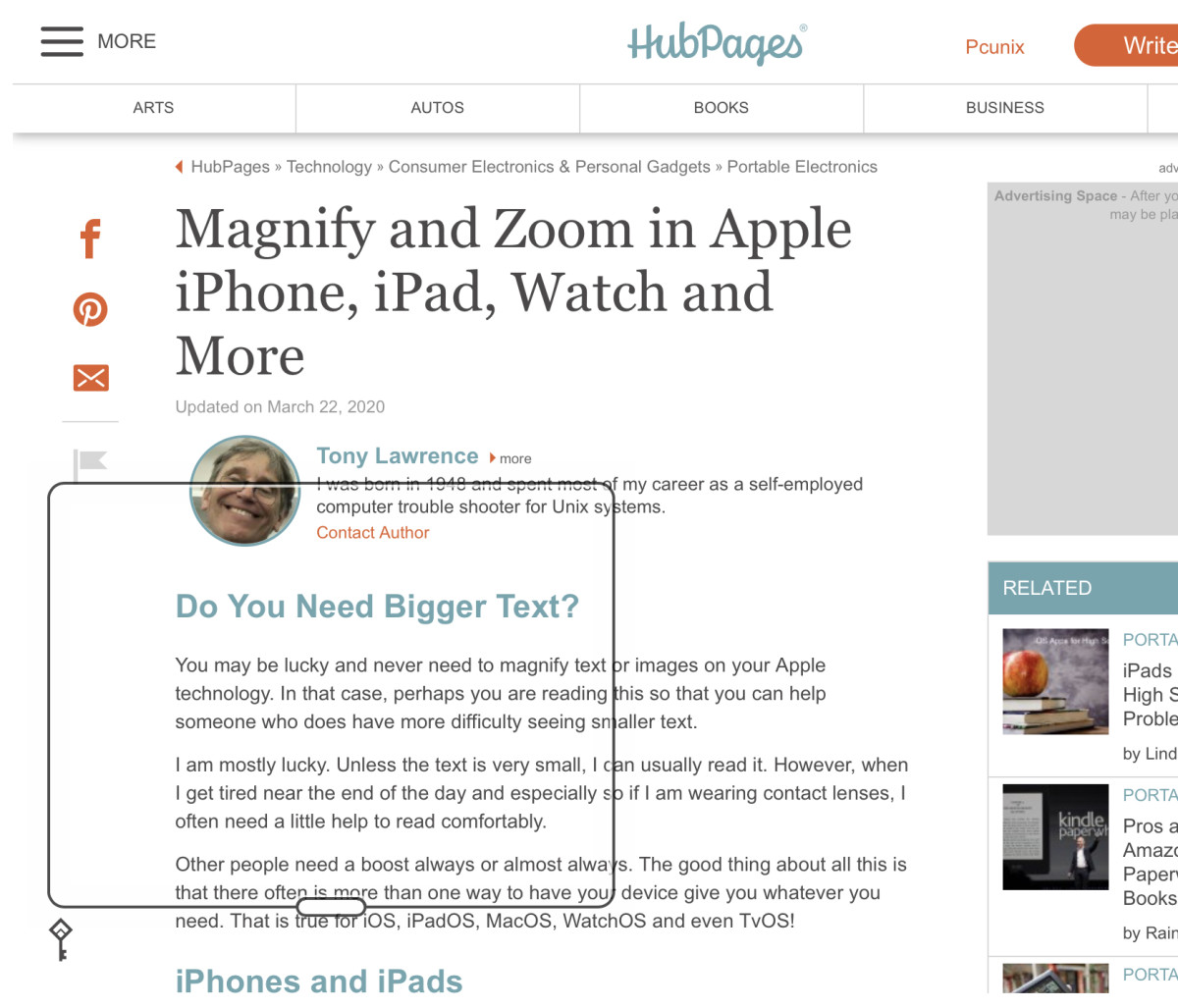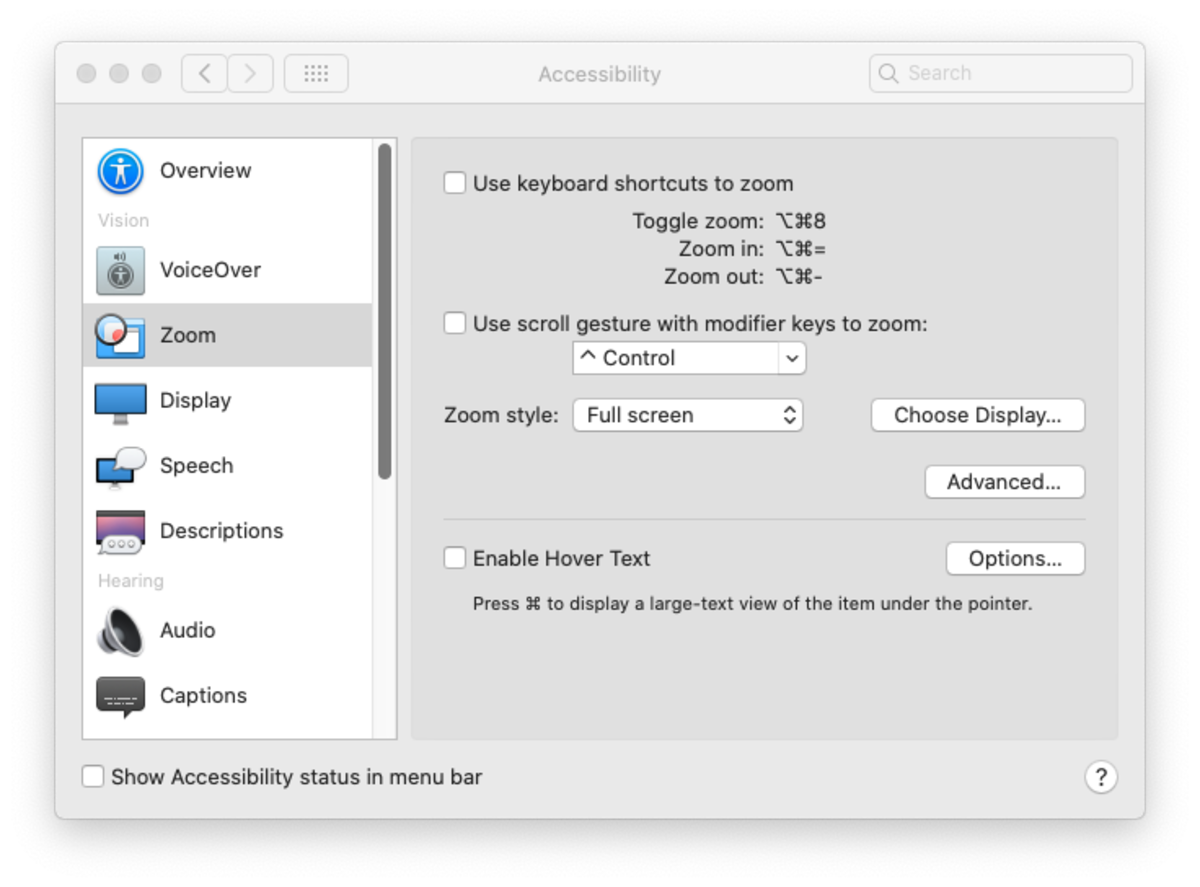I am mostly lucky. Unless the text is very small, I can usually read it. However, when I get tired near the end of the day and especially so if I am wearing contact lenses, I may need a little help to read comfortably. Other people need a boost always or almost always. The good thing about all this is that there often is more than one way to have your device give you whatever you need. That is true for iOS, iPadOS, MacOS, WatchOS and even TvOS!
iPhones and iPads
It has been my experience that most people are aware of changing the text size under Settings->Display and Brightness, and that they can use a pinch-out gesture in a few places, but that’s all they know about. Certainly increasing the text size is useful, but it doesn’t increase the size of all text everywhere. As there are often other things we need some help seeing, Zoom, which is found in Accessibility, answers that need. After enabling it in Settings, a simple three-finger tap zooms up either the whole screen or optionally will bring up a sliding window that magnifies whatever is under it. Three-finger tap again to revert to your normal size. You can move the magnified window around using the little handle at the bottom of it. Tapping on that handle brings up a menu that lets you change the zoom region, increase or decrease the magnification (up to the maximum you set in Settings) and more. You can also pin the window to the top, bottom or sides of the screen and apply color filters. I’ve never found a use for those things, but there must be someone who needs them. Things outside of your phone or iPad can sometimes be hard to see also. Don’t forget that you can use your camera and pinch in and out to magnify anything, including things that are far away. That’s easy enough, but there is an Accessibility function called Magnifier that’s even better. It looks a bit like the Camera app, but the button only freezes the screen, it doesn’t save the image. You can save it if you like, see Use Magnifier with your iPhone or iPad.
Apple Computers
Most MacOS applications have preferences that let you control font styles and sizes, but some do not or do not give you control of everything you’d like to set. There is a Zoom setting in System Preferences->Accessibly that lets you zoom anything on the screen with keyboard control or a trackpad. Like iOS above, that can be the full screen or a window. On macOS, that window just follows your cursor. That is very useful, but actually there’s a zoom feature built in to a few applications that requires no configuration at all. Just hold Command (the key to the left of the space bar) and tap the “+” key. If you are in Safari or Chrome and probably most or all MacOS browsers, the screen will zoom larger. Command and “-“ decreases the size and Command 0 returns you to normal size. Many macOS keyboard shortcuts, including these, will work on an iPad if a keyboard is attached. To see everything, just hold down the Command key on the iPad keyboard. Those Command key shortcuts may work similarly in some other apps. For example, Command Plus in Xcode will increase the size of text in an editor window. There are certainly others.
Reader View
While not much of a magnifier, Reader View does greatly improve readability and of course you can zoom it up using other methods too (pinch out or zoom). In the picture above the left side is a normal webpage while the right side shows it in Reader Mode. To get Reader Mode in iOS and iPadOS, you click on the Aa in the menu bar. If the website supports it (not all do) Reader View will be an option. MacOS uses a little stacked bars symbol to show that Reader View is available. Click it to toggle this view. You can also choose Website Settings to have Reader View be the default for any website that supports it. Go ahead, try it on this page.
Apple Watch
You can change the text size in Settings->General->Display and Brightness but as always, this won’t necessarily affect all apps. The small size of the watch itself means that only so much text can fit on the screen, so making this very large may not be what you want. Zoom, which is as usual found in Accessibility, can be turned on but again you’ll run into the problem of the screen being small to start with, so I’d suggest not cranking it up too high. Don’t set it too low either. Even if you set it all the way up, the two-finger tap that activates it will only zoom up a reasonable amount. If you want more or less, double-tap with two fingers but do not lift your fingers on the second tap. Just slide up or down to change the amount of magnification. Double-tap with two fingers again to go back to the normal size. While magnified, you can hold two fingers on the screen and move them to see more of the screen. That seems to be a bit hard for some folks to master. Be patient, it does work.
Apple TV
This refers to the newer Apple TV hardware; I do not own an older model to test. There doesn’t seem to be any general setting for text size on Apple TV, but there is a Zoom setting. You probably won’t use it very often, but once in a while, you may want to hit that pause button and zoom in for a close look at some detail on the screen. As with everything also, turning Zoom on is found in Settings->Accessibility. That’s easy enough and you can set the maximum zoom there also. Actually using it is a bit trickier. The instructions tell you to double-tap with two fingers on your remote‘s to surface and drag up or down to adjust zoom. What they do not tell you is that you need to double-tap and, without lifting your fingers, drag up down to change the zoom level. That’s the same as Apple Watch. I also needed to change the Touch Surface Tracking speed under Remotes and Devices. Moving around when zoomed is easy enough once you get the hang of it. After zooming, switch to one finger to move things around by dragging on the remote touch surface.
Anything Else?
I didn’t go into full detail on every possible setting and option, but I hope I gave you enough to explore and be able to see what you need to see. © 2020 Tony Lawrence






